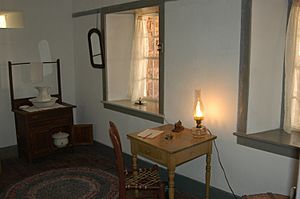Pipe Spring National Monument facts for kids
Quick facts for kids Pipe Spring National Monument |
|
|---|---|
|
IUCN Category III (Natural Monument)
|
|

Winsor Castle
|
|
| Location | Mohave County, Arizona, US |
| Nearest city | Fredonia, AZ |
| Area | 40 acres (16 ha) |
| Created | May 31, 1923 |
| Visitors | 25,179 (in 2018) |
| Governing body | National Park Service |
| Website | Pipe Spring National Monument |
Pipe Spring National Monument is a special place in Arizona, USA. It's full of amazing history about Native American tribes, early explorers, and Mormon pioneers. The National Park Service takes care of this important site. It became a National Monument on May 31, 1923.
Contents
Exploring Pipe Spring's Past
Ancient People and Early Explorers
Water is super important at Pipe Spring! This natural spring made it possible for plants, animals, and people to live in this dry desert area. For over 1,000 years, Ancestral Puebloans and Kaibab Paiute people lived here. They gathered seeds, hunted animals, and grew crops near the spring.
In 1829, a Spanish explorer named Antonio Armijo found the springs. He was traveling through the area on the Old Spanish Trail.
Mormon Pioneers and Winsor Castle
The name "Pipe Spring" was given in 1858 by Jacob Hamblin. He led a group of Latter-day Saint missionaries. In the 1860s, Mormon pioneers started a large cattle ranch here. James M. Whitmore brought the first cattle to the area.
In 1866, several Native American tribes raided Pipe Spring. Because of this, a strong fort was built over the main spring by 1872. The next year, Brigham Young bought the fort and ranch for the Church of Jesus Christ of Latter-day Saints.
Anson Perry Winsor was hired to run the ranch and fort. The fort soon became known as Winsor Castle. This isolated outpost was a stop for people traveling across the Arizona Strip. This part of Arizona is separated from the rest of the state by the Grand Canyon.
The Kaibab Paiute Indian Reservation
The lives of the Paiute Indians changed a lot after the Mormon settlers arrived. However, they continued to live in the area. In 1907, the Kaibab Paiute Indian Reservation was created. It surrounded the Pipe Spring ranch. In 1923, the ranch was bought and made into a national monument. It was meant to remember the pioneer life in the American West.
Visiting Pipe Spring Today
Today, you can visit the Pipe Spring National Monument. There's a Kaibab Band of Paiute Indians Visitor Center and Museum. It teaches about the history of the area and its people.
You can take daily tours of Winsor Castle. In the summer, you might see "living history" demonstrations. These show what life was like long ago. There's also an orchard, a garden, and a short trail to explore. These give you a peek into Native American and pioneer life in the Old West. The Paiute tribe also runs a small campground nearby.
Climate at Pipe Spring
Pipe Spring National Monument has a semi-arid climate. This means it has cold winters and hot summers.



